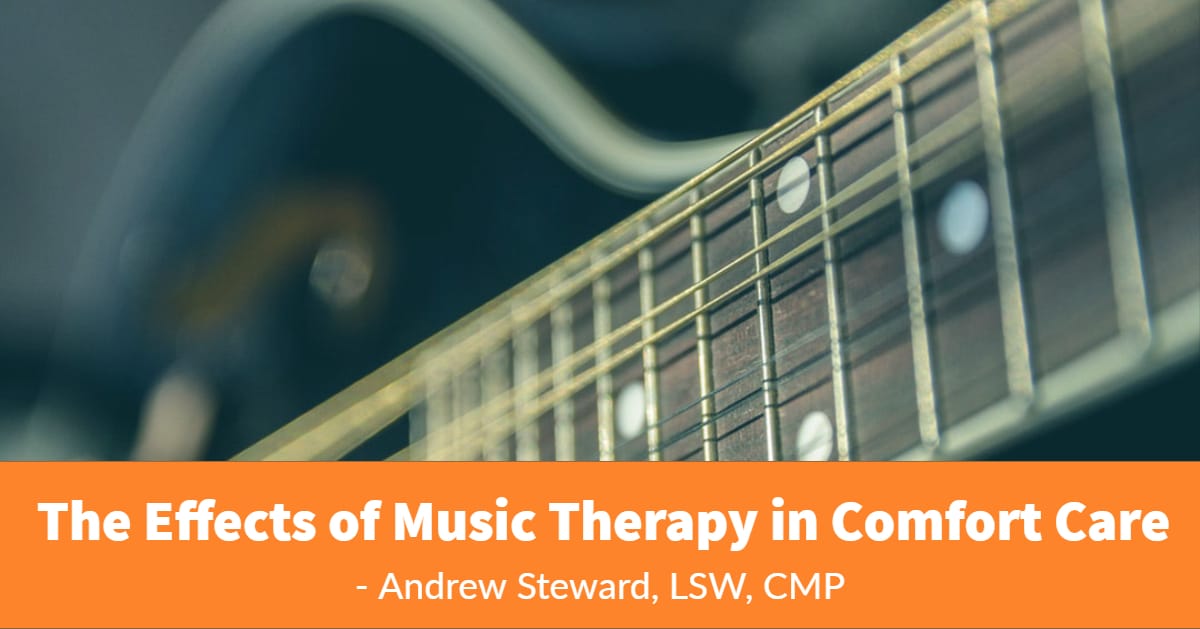The Effects of Music Therapy in Comfort Care
by Andrew Steward, LSW, CMP
Music therapy is a powerful tool in end-of-life settings. More than a tool, it is a language that reaches people with a variety of health conditions. How does one engage with a patient who is non-verbal? Dying? Living with advanced dementia? Agitated or restless? In many cases, words do not help and may only make things worse. Music is a language that all people understand and can relate to, despite differences in cognition and other challenges.
As a Medical Social Worker and Certified Music Therapy Practitioner, I have witnessed numerous powerful and impactful responses to music therapy in hospice care. The following are only a few, recent stories:
- A patient with a repetitive tremor before and after a music therapy session, but which was absent with music.
- A patient who was “unable” to lift their head, even with assistance from a caregiver, but upon the start of live music, lifted her head with completely straight posture and smiled for about 10 minutes.
- A patient who didn’t speak for at least 3 months and after a music therapy session spoke three words clearly.
- A patient was agitated, chanting “Dying! Trying!” repeatedly. Words made things worse. During the music session, the patient stopped chanting and all restless movements ceased. She sank into her chair and began eating a snack and drinking juice.
These stories may seem miraculous or “too good to be true.”
These stories may seem miraculous or “too good to be true.” But they are not tall tales. So what is it about music that makes it so powerful? What elements of music help to organize sound into a therapeutic language, which has a noticeable effect on people with various conditions?
- Repetition in music creates a relaxing or hypnotic effect.
- Rhythm provides structure and security. It also reflects the natural reaction of bodily pulses, such as the heartbeat, breath cycle, and brainwaves.
- Harmony helps the listener to resolve and release tension.
- Melody has the power to soothe by taking the listener away from physical awareness, allowing visual fantasies to take shape in their minds (similar to guided visualization).
- Timbre, or tone color, naturally creates different moods and resonates in specific areas of the body.
- Form gives shape and tells a story.
- Drones (long, interrupted sounds) provide an emotional sense of security.
(Leeds, The Power of Sound, 2010).
So what is it about music that makes it so powerful?
Research also validates the efficacy of music therapy in comfort-care settings. Peterson and Fanning (2013) found that music therapy at the bedside had a stabilizing effect on patients’ physical and emotional well-being. They observed conditions such as lowered restlessness and disorientation, as well as the patients’ lowered blood pressure after music. Clarke, Lipe, and Bilbrey (1998) found music to be effective in decreasing aggressive behaviors for people living with dementia. Cooke and colleagues (2010) studied the effects of music on quality of life and depression in older adults with dementia and found improvements in self-esteem and belonging, as well as fewer depressive symptoms over time.
But the evidence has not only pointed toward music providing psycho-social benefits. Live music sessions have also been used as a holistic intervention toward reducing pain, anxiety, and muscle tension (Sand-Jecklin & Emerson, 2010). The effect of music therapy also extends beyond the patient, as one study found that live music has a positive effect on human contact/care relationships, better communication, and an improved relationship between caregiver and receiver.
You may be thinking, what if I am not a trained musician? Consider the importance of sound within the environment for a hospice patient. Do you have a patient or loved one who struggles to sleep because their nursing home roommate leaves the television on all night? When visiting a hospice patient, do they ever comment that they have trouble hearing you in the loud common area with kitchen noise and several other conversations occurring at the same time? How about in the hospital setting, which always seems to have several loud, beeping machines nearby at any moment?
All music is sound and sound is music. The volume of the environment around a patient can make a significant difference to their mood and general temperament in addition to simply being able to hear your conversation. While entering the room, survey the sound level. Does it sound chaotic? Tense? Confusing? Scan your body and consider how, physiologically, the sound around you may be affecting your stress levels. How can you help to create a calmer, more peaceful environment for the person you are visiting, before you even begin to engage in conversation? It may make all the difference.
An interesting musical concept is called entrainment. Entrainment is the effect of one system on another and basically means that any two vibrating bodies will try to synchronize with one another. First studied in 1665, Dutch scientist Christian Huygen found that two pendulum clocks which were slightly apart in time eventually began to synchronize when placed next to one another. Whether you are a musician or not, your body is a vibrating, expressive tool, similar to an instrument! Consider how your tone of voice, non-verbal expressions, and emotional energy may entrain with, or be mirrored by, the hospice patient you are visiting. As Joshua Leeds states in his book, The Power of Sound (2010), “Music alters the performance of the nervous system primarily because of entrainment.”
“The effect of music therapy also extends beyond the patient…”
Overall, music has a therapeutic quality because it invokes the parasympathetic nervous system, or “relaxation response.” This is the opposite of the “fight or flight” response. Music calms the mind and body, releases tension and brings soothing feelings. Patients are not the only individuals music therapy can benefit. Families of hospice patients are often in panic-mode, due to the overwhelming emotional, financial, and logistical stressors they find themselves experiencing. It is not uncommon for hospice practitioners and facility care teams to also find themselves burning out and feeling caught in this “fight or flight” state. Whether you are a musician or not, you can make a difference by altering sound within the environment for hospice patients. This can be done by simply turning off the TV or radio. Taking a patient or loved one outside to a quiet courtyard, mindfully observing the sound of the wind or birds, may provide significant therapeutic benefit. If you play a musical instrument, consider becoming trained as a Music Therapist (which requires a four-year degree and board certification) or Certified Music Practitioner through the Music for Healing and Transition Program (www.mhtp.org). There is music all around us which affects our physiology, comfort, and overall well-being.
References
Clark, M.E., Lipe, A.W., Biblrey, M. (1998). Use of music to decrease aggressive behaviors in people with dementia. J Gerontol Nurs 1998 Jul; 24(7):10-7, PMID: 9801526.
Cooke, M. et al., (2010). A randomized controlled trail exploring the effect of music on quality of life and depression in older people with dementia. J Health Psychol; 15(5): 756-76, PMID 20603300.
Leeds, Joshua. The Power of Sound. 2010. Healing Arts Press.
Peterson, K., Fanning, E. July 2013. Collecting information on observable and measurable effects pre- and post- live therapeutic music sessions at patient’s bedside. Unpublished study (Presented at ISQRMM Conference July 2013 University of Georgia).
Sand-Jecklin, K., Emerson, H. (2010). The impact of live therapeutic music intervention on patients’ experience of pain, anxiety, and muscle tension. Holist Nurs Pract; 24(1): 7-15, PMID 20023519.
Van der Vleuten, M., Visser, A., Meeuwesen, L. (2012). The contribution of intimate live music performances to the quality of life for persons with dementia. Patient Educ Couns; 89(3): 484-488, PMID 22742983.
Sold Out hospice stories on our hospice blog
Please feel free to contact us with any questions regarding hospice care


